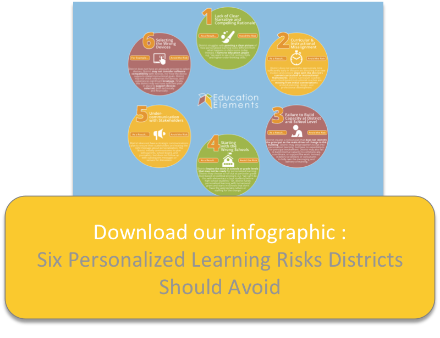
6 risks to avoid when implementing personalized learning: part 2
personalized learning | competency-based education | school districts
in our first post of this series, we reviewed the first three risks for districts that move to personalized learning:
- risk #1: lack of clear vision, narrative, and rationale
- risk #2: curricular and instructional misalignment
- risk #3: failure to build capacity at district and school level
today, we’ll round out our list with the last three risks we often see:
- risk #4: starting with the wrong schools
- risk #5: under-communication with stakeholders
- risk #6: selecting the wrong devices
risk #4: starting with the wrong schools
we often see districts begin rolling out personalized learning in schools or grade levels that may not be ready for the change. the decisions are sometimes made due to political or funding pressures.
for example, district leaders may feel pressured to start at the high school level to fix low engagement or poor academic results. additionally they may worry that parents and community members will object to providing elementary school students with additional devices or technology before high schoolers. in fact, elementary school is a great place to begin personalized learning!
additionally, we often see investment in personalized learning -- technology, professional development, coaching positions, or design services -- funded by turnaround grants. while we strongly believe personalized learning is the right approach for all students, turnaround schools have unique challenges that may make it difficult to see early wins. turnaround schools often do not have the appropriate culture or staffing to sustain the change that personalized learning requires.
by starting personalized learning in places where it may take a long time to see success, district and school leaders may be unable to identify early wins that would help them increase buy-in across the district and with external stakeholders, e.g. parents and school board.
to avoid this risk, districts should:
- start with their strengths – schools who are instructionally and culturally ready to move forward right away
- pay attention to timing of rollout – determine if start of year or mid-year is most appropriate for schools
- change course or go slower if needed
- be open to schools or classrooms starting at different places and moving at different paces
risk #5: under-communication with stakeholders
districts often fail to create a strategic communications plan to ensure their stakeholders are hearing the right message about personalization. a district may initially communicate their plan with parents, school board, and journalists, but they fail to follow up with subsequent messages or venues for discussion.
lack of a communications plan can have many implications. parents may only hear about the infusion of technology into classrooms, not the pedagogical changes, and think that their students are not getting sufficient instruction from teachers: “teachers aren’t doing their job!”
many times the school board does not understand the criteria by which the district will measure success of the work. they do not know the difference between “this is not working” and “this just takes more time,” and withdraw their support.
finally, we’ve seen instances where journalists have not been provided with consistent information about the rollout, and therefore write stories with inaccurate information or cover schools with poor implementations.
to avoid this risk:
- create a strategic communications plan for each stakeholder group
- ensure plan includes spiraled approach – not just at start of the year
- identify strong schools and teachers early in the process to show examples of success
- empower teachers to speak about the initiative
risk #6: selecting the wrong devices
we’ve saved this risk for last because it’s one of the most talked about. poor device decisions often attract the most publicity, and for that reason districts have a laser-like focus on device selection -- a critical decision for sure, but we want to make sure this risk doesn’t overshadow the others on the list.
districts often run into problems when they don’t have an adequate process to select devices and thus encounter major problems once devices are deployed to students. for example, a district may not consider software compatibility with devices, nor how the device supports stated instructional goals. a district may not check references for devices, and as a result experience significant breakage. finally, a district may not have a plan in place to support devices selected, both technically and financially, which can result in unusable devices stacked in hallways and offices. talk about a pr nightmare!
to avoid this risk:
- carefully consider your instructional goals and how each device would support those goals
- rigorously check references for all devices
- pilot devices before purchasing district-wide
- create financial and technical sustainability plan
as we conclude this two-part series on district risks, you may be thinking, “what dire news! why would i ever consider putting my district through this change with all the pitfalls i might encounter?” we’d urge you to take heart -- it’s worth it, and we owe it to our students. you’re starting to think about this change at the right time. we’re just now on the precipice of having many more districts pursue smarter, better use of technology to enable personalized learning. i, for one, am grateful to the pioneering districts who took this leap, and from whose experiences we can all learn.
check out the 6 risks to avoid when implementing personalized learning: part 1
about janice vargo
janice is an associate partner on the design and implementation team at 瑞士vs喀麦隆亚盘赔率 . she has supported a diverse group of districts in their personalized learning journey. prior to 瑞士vs喀麦隆亚盘赔率 , janice was a senior consultant for upd consulting where she supported state education agencies, k-12 school districts, and nonprofits on a variety of policy and technology projects. she holds a master’s degree in public policy from the harvard kennedy school of government and a bachelor’s degree in american studies and spanish from the university of notre dame.




